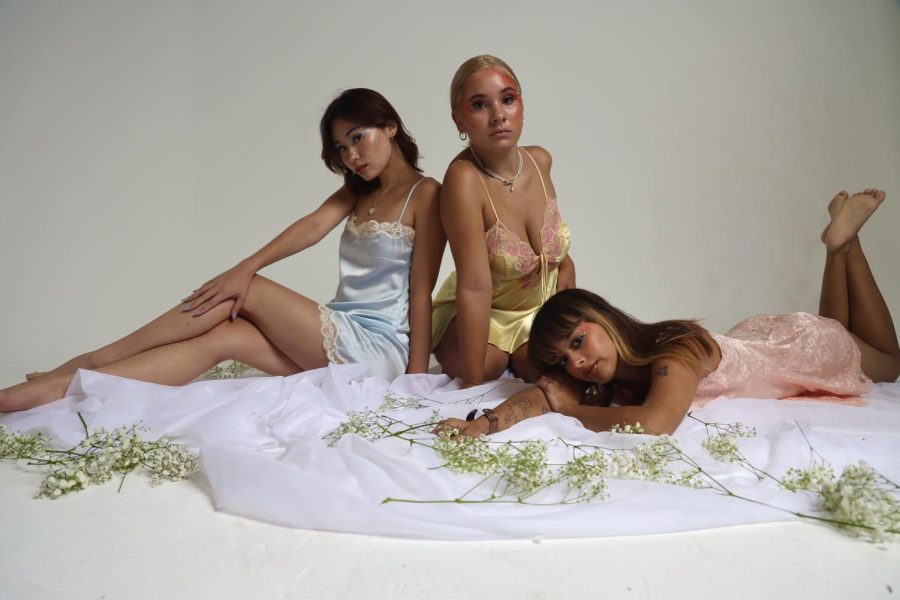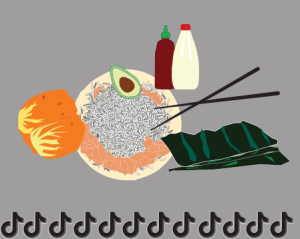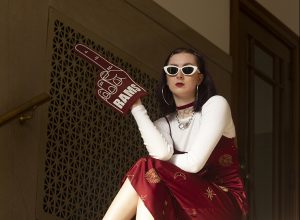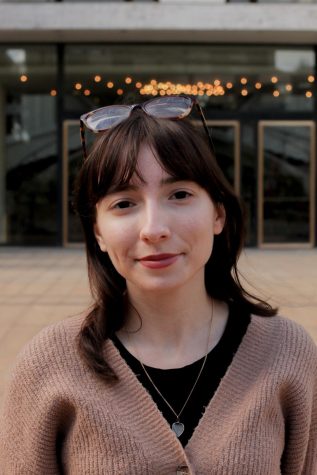Breaking the Fashion Cycle of Exclusivity
Fordham students offer their perspectives on one of the largest industries in the world
GROOVE WORLD SHOOT COURTESY OF UNO VALENTINE
Uno Valentine, left, is a model and digital technologies major who recognizes the connection between fashion and social media.
February 27, 2022
During New York Fashion Week, almost anyone can go out, dress up in their shocking fabrics, strike poses and snap photos. But a ticket to the shows with the raucous music, A-list celebrities, and camera flashes beheld to us in “The Devil Wears Prada” and “Ugly Betty” appear as renditions of a competitive, cutthroat and all-around exclusive fashion bubble.
The lives of glamorous New Yorkers seem just out of reach, and the fashion world seems locked behind velvet ropes.
According to model and digital technologies and emerging media major Uno Valentine, Fordham College at Lincoln Center (FCLC) ’23, “Exclusivity kind of creates this whole environment around it that kind of draws people in.”
There is an intimidating core to the fashion industry that formulates a comparison-driven mindset, transcends fashion events and is transmutable across social media platforms.
When people yearn for inclusion in an industry with a runway of unreality cutting through it, how does one conquer that catwalk in couture?
“There is a certain sense of urgency in the whole industry.” Patrick Tormey, former Business of Fashion professor
Putting in the Work
There is a paradox in fashion’s portrayal that the work is either frivolous or bone-crushing in a largely female-directed luxury media image.
Patrick Tormey, former Business of Fashion professor and current Ground Floor instructor in the Gabelli School of Business, claims the fashion world is “always trying to find newness and try to capitalize on being the first one with the newest item. There is, (then), a certain sense of urgency in the whole industry.”
Breaking into a field that emphasizes the “fast” and “ready” takes grit that students such as Carrie Berk, FCLC ’24 and contributor to The Observer, and Valentine recognize.
Berk, a journalism and fashion studies student, grew up attending fashion week. She considered it to be integral in her path to a career at Vogue.
She is devoted to her work, which entails writing a fashion blog called “Carrie’s Chronicles,” maintaining a TikTok with 3.4 million followers, starring in a new show on Paramount+ titled “Next Influencer,” and attending fashion shows such as YDAMYS SIMO and J.Mendel.
Meanwhile, Valentine focuses on fashion separate from her interest in technology and public health. Valentine signed with MMG last year after her aunt, a long-time attendee of fashion week and technical worker in the industry, encouraged Valentine to pursue modeling.
“(Modeling) is not really a thing you can pick up and put down because it’s all about growing what you already have.” Uno Valentine, FCLC ’23
A self-proclaimed perfectionist with an ambition for multidimensionality, Valentine views balancing school and modeling to be rigorous and rewarding.
“(Modeling) is not really a thing you can pick up and put down because it’s all about growing what you already have,” she said.
Working on projects with the likes of Emma Rogue and unisex undergarment company Parade, Valentine continues to grow her community of artists and friends who then invite her to shows and may consider her for projects.
Walk the Walk
Fashion week is a two-fold event to Tormey: a chance for established designers to exhibit their fresh styles and trends and an opportunity for the up-and-coming to establish themselves.
In the same way, Tormey said, “the fashion industry needs people that are clear thinkers.”
For students to get a ticket to fashion week is difficult, but many behind-the-scenes interns are invited to fashion week.
Fashion consists of a diverse range of marketing, sales, media, development, technical and management positions. Among his own students, he has seen many recruited by PVH (their brands including the likes of Calvin Klein and Tommy Hilfiger), work at the e-commerce company Rent the Runway, and hired at fashion magazines.
Tormey established that for students to get a ticket to fashion week is difficult, but many behind-the-scenes interns are invited to fashion week.
The Influencers and the Influenced
One avenue in which Fordham students and many others have garnered interest is in the influencer world.
Berk said, “I feel like there are a lot of influencers attending fashion week. It used to be fashion tyrants, celebrities, but now you’re seeing the rise of the influencer, so there are a lot of influencers sitting front row at fashion week, getting the interviews, getting street style photos, et cetera.”

The emergence of influencer culture provides a chance for the reality of the industry to be made accessible to wider audiences and brings in a diverse perspective to the field.
However, social media posts of perfectly fitted, gifted outfits from influencers play into the paradox of unattainability in the industry, even though these influencers are merely fulfilling their job description.
“If you see all of your favorite influencers going to this show, it kind of warps this show into something ‘Oh, that’s not something I could ever be a part of or that I could enjoy’… I think that feeling is relevant in a lot of different aspects (of the industry),” Valentine said.
People can feel closer to a fashion experience based on an influencer’s insider perspective, yet that angle also garners comparison.
Valentine’s view on fashion shows is that they are supposed to resemble that during- and post-concert feeling, where one admires the work and may take inspiration from some aspect of it — rather than fashion as another chance to succumb to the industry’s standards.
“You may be exactly what someone else is looking for, just not this person.” Uno Valentine
Artists Supporting Artists
To Valentine, fashion exists in creativity and meaningful collaboration: “If someone is doing a watercolor painting and you bring them chalk and say, ‘These are the materials I have,’ they’re going to be like, ‘Okay, well that’s not really what I need,’ but it doesn’t mean that what you have is really terrible, and no one wants it because you didn’t bring the watercolor paints. You may be exactly what someone else is looking for, just not this person because they’re looking for watercolor.”
Those who empower artists in the fashion community may be looking for the chalk. Valentine recommended that Fordham students looking to break into the industry should contact people who create inspiring and inclusive work, no matter the size of the project.
As Tormey likes to say, “the only constant is change.” This is especially true of an industry with endless variety, constantly in competition to break boundaries and avert expectations.
In the industry’s cyclical rebranding, it is important to people such as Valentine that those entering a duplicitous field remember to protect their heart and their confidence as their greatest assets. “Fashion is about clothes and art,” she said.
There are no singular guest lists, invitations or requirements in creating and sharing art.














